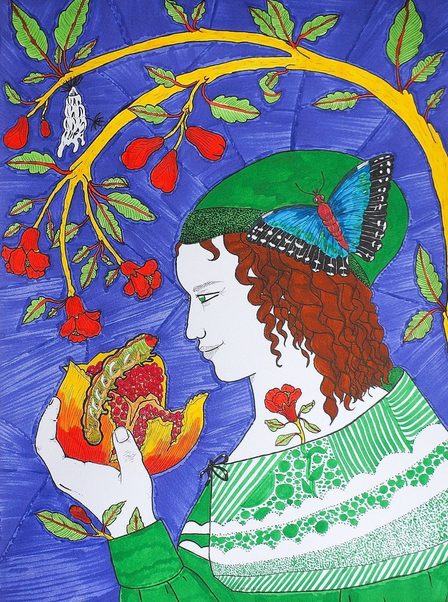Ode to Maria Sibylla MerianThe portrait is finished

This text was translated using AI and may contain errors. If you have suggestions or comments, please contact us at info.ode@amsterdammuseum.nl.
Maria Sibylla Merian,
My letter to you contains no handwriting. I am writing to you from another time. My century is dedicated to rewriting and completing stories we have incompletely inherited, women's names are the missing shards lifted from the past with great caution - your name is well preserved, barely tarnished by water.
The entrance to your world is low to the ground, hidden behind dandelions and nettles. Only creatures that crawl and fly come here. With rubber gloves, I bend aside the nettles and lower myself into a dark space filled with countless silky cocoons. Despite the darkness, everything is bright. Blue wings brush along my cheek and in a flash I see the winged eyes you once put on paper with surgical precision.
You are kneeling on the ground, a girl still. You are wearing a loose dress and your hair is tightly braided back. Butterflies land on your back like a flashing cloak. I come and sit opposite you but you don't look up, enchanted by the caterpillar in your hands. This is the beginning.
I draw a portrait of you with ecoline, observing you as you observe the spiders, butterflies, lizards and frogs. It is the seventeenth century and together with your daughters you have set up a studio in Amsterdam. You give drawing lessons to girls from distinguished families and from the proceeds you pay for your own trip to Suriname for your scientific research.
“Ik teken een portret van jou met ecoline, ik observeer je zoals jij ook de spinnen, vlinders, hagedissen en kikkers observeert”
Space fills with dense whispering forests and a gurgling river, and you make your way through the vegetation. You are not alone. You are led by women who point out the right plants to you and explain their effects, women whose real names lie on the river bottom, women who no longer own their own bodies and perform forced labour on sugar plantation La Providence.
A woman bends a beautiful red-orange flower towards you, carefully, you look at the cocoon hanging like a promise among the leaves, and the woman tells you that she uses the seeds of the peacock flower for abortion so that her children will never be enslaved. You write in your notes: ‘The Indians, who are not treated well, when they are employed by the Dutch, drive off her children, not wanting her children to be Slaves, as they are.’ You leave out the names of the enslaved women.
My portrait of you is almost finished. You return to the Netherlands and publish the work that will make you famous, Metamorphosis Insectorum Surinamensium. Your scientific illustrations reveal the secret of metamorphosis at a time when insects were believed to emerge from mud. Your name is well preserved, hardly affected by the water but the names of the women without whom your work would have been impossible cannot be resurfaced. The portrait is finished - you hold a pomegranate broken open, a yellow caterpillar clambers over the red flesh and you have eyes for nothing else in this bygone night teeming with wingbeats.
Ola Enzler
Period
1647– 1717
About
Ode by Ola Entzler to Maria Sibylla Merian
Maria's beautiful illustrations reveal the secret of metamorphosis at a time when insects were believed to emerge from mud. She goes against all the conventions of the 17th century by setting up an independent studio in Amsterdam with her daughters, and from her proceeds she funds her own trip to Suriname, where she records the secret lives of butterflies, frogs and tarantulas.

Maria Sibylla Merian
Anna Maria Sibylla Merian (Frankfurt am Main, 2 April 1647 - Amsterdam, 13 January 1717) was a German artist and entomologist who studied plants and insects and produced detailed drawings of them. In her publications, she herself never used her first name Anna.